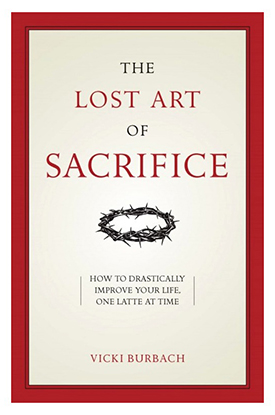An invitation to ‘The Lost Art of Sacrifice’ — a powerful part of our faith

Reviewed by Lindsey Weishar
In a culture in which the concept of sacrifice is often either misunderstood or ignored, Vicki Burbach’s “The Lost Art of Sacrifice” invites readers to delve into a powerful part of our Catholic spirituality.
A compelling image Burbach offers for understanding sacrifice is her experience of teaching swimming students how to float. She mentions that this was initially a struggle for many students, who didn’t know how they’d fare floating on their backs. A student advanced rapidly once he learned “he could get along much better in the water by surrendering his control, by allowing his body to rest comfortably amid the gentle sway of water, trusting that my hand would stay securely beneath him as long as necessary.”
Whether a companion for Holy Week or a meditation for your Easter season, Vicki Burbach’s “The Lost Art of Sacrifice” offers food for thought to Catholics wondering how to more deeply give of ourselves to God, to others, and by extension the whole Body of Christ.
This trust not in ourselves, but in God, makes the idea of sacrifice not only more approachable, but invites us each to examine our own personal relationship with it. That sacrifice is “a free gift of yourself” to God and to others, and is often carried out in the simple moments of daily life may be encouraging to readers who feel that sacrifice requires more than we can give. As Burbach makes clear throughout the book, it really only requires our love.
“CONNECTED TO OUR NEIGHBORS”
The book is broken into three parts: framing sacrifice, pointing out patterns of thinking in our current culture that deemphasize or distort sacrifice, and exploring the art of sacrifice as both an interior and exterior way of life. In the first two parts, each chapter ends with a section called “cultivating the art of sacrifice,” which offers a few actionable steps for giving of ourselves in daily life. For example, readers are prompted to ask themselves, “What are you holding onto that prevents you from giving yourself completely?” and to consider spiritual practices like adding the morning offering to one’s prayer routine.
Most compelling for this reader was the call to consider how my sacrifices benefit the Body of Christ.
“As part of his body,” Burbach notes, “we are as intimately connected to our neighbors as our arms are connected to our hands, or our legs to our feet. In other words, our prayers, acts of penance, mortification, and other sacrifices can and do have a direct effect on those around us . . .” Thinking of my acts of sacrifice as little ripples in the grand pool that is the spiritual world has given me greater context for my offerings.
A WAY OF LIFE
Though the book does well in outlining some cultural misunderstandings surrounding suffering (Burbach mentions socialism and modernism as examples of ways that sacrifice is either mandated or discarded), in places there does seem to be a stark dichotomy between the culture/world and God, between the body and the soul.
The book also had opportunity for greater nuance in its nod toward “indescribable suffering” like abuse or trauma. In some cases, it might be harder for a person to “be comforted in knowing that all suffering is a gift from God and He allows such pain for the betterment of our souls and for the benefit of His Body, the Church.” This simply may not be how all souls process such pain, especially if the wound is fresh or ongoing. The fact that we can offer to God all of our suffering is, however, a marvelous gift, and Burbach highlights this especially in sections one and three.
Lest the call to sacrifice feel overwhelming, the third section of the book is an invitation to immersion — sacrifice not only as individual spiritual practices, but sacrifice as a way of life. She gives suggestions of how sacrifice can be carried out through each of the corporal and spiritual works of mercy. She also highlights interior dispositions that allow us to accept and choose sacrifice more readily, including generosity, time for personal recollection, and an openness to mortification (“exterior mortification,” which “denies or limits the flesh for the sake of some spiritual good” and “interior mortification” which enables us to “repress selfish affections of the mind and heart”).
She frames the call to persevere in carrying out small sacrifices with the present moment in mind: “I think more in terms of gifts of God that I can offer right now. I focus on today. There are a lot of things I can do for one day.”
Whether a companion for Holy Week or a meditation for your Easter season, Vicki Burbach’s “The Lost Art of Sacrifice” offers food for thought to Catholics wondering how to more deeply give of ourselves to God, to others, and by extension the whole Body of Christ.
—
LINDSEY WEISHAR is a poet, freelance writer, and member of St. Matthew Parish in Champaign. She has a master of fine arts degree in creative writing from the University of Missouri-Kansas City. Write to her at lweisharwriting@gmail.com.






